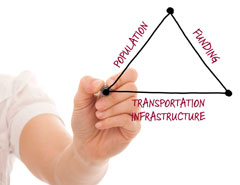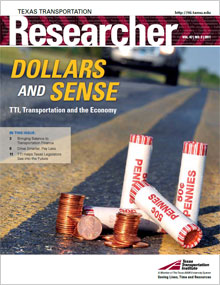What It Takes Is Dollars and Sense

Getting where you’re going costs money. Whether that’s bus fare, filling up your gas tank or keeping our transportation system operational, it all costs money. And it’s getting more expensive. How much we pay at the pump might be the most visible reminder that transportation isn’t free, but it’s not the only reminder.
Recently, Texas Transportation Commission Chair Deirdre Delisi asked Texas’ 2030 Committee to take another look at our state’s transportation needs. (The original committee produced a 2008 report projecting needs through 2030.) The revised version gets more specific by examining the cost/benefit ratio of investing now in efforts to address the effects of increased population and failing infrastructure through 2035.
Essentially, the revised report concludes that the longer we wait to mitigate those problems, the more we’ll pay in the end. That future cost could come through monumental maintenance expenses, increased prices for goods in stores (costs passed along by manufacturers using a substandard transportation system to get their goods to market), lower quality of life (less time spent with family, more time spent in traffic) or jobs moving out of state.
In this issue of the Texas Transportation Researcher, we tell you more about this latest call to action from the 2030 Committee. We also tell you how the Texas Transportation Institute (TTI) is helping our sponsors be more accountable to the citizens of Texas. For example, TTI recently helped the Texas Department of Transportation (TxDOT) create a customer satisfaction program to better assess how Texans view TxDOT‘s performance. And our assessment of the Loop 410 expansions in San Antonio will help TxDOT better plan improvements in other urban areas to get the best bang for the taxpayer’s buck.

We’ve also been abroad teaching road design courses in Kosovo to help our global neighbors improve their own transportation systems. At home we’re assisting TxDOT and other sponsors to improve how they maintain the roads with software like FPS21 and techniques like PANDA. The longer the roads stay in one piece, the less they cost over time, and we’re sharing those lessons learned with other states to help them plan more sustainable transportation systems.
Finally, our feature story takes a look at that most visible sign of transportation and the economy — how much you pay at the pump. We ask TTI Research Scientist Dave Ellis why gas prices rise and fall; and Joe Zietsman, head of TTI‘s Environment and Air Quality Division, gives some pointers for saving gas and money by driving smarter.
So we’re back where we started: the system costs money. But how and when we spend that money and how much we spend — those are factors we can control. Research helps us do that. It shows us how best to optimize the system, minimize expenses and maximize safety while ensuring a viable return on our investment. In short, research shows us how best to balance dollars and sense.
